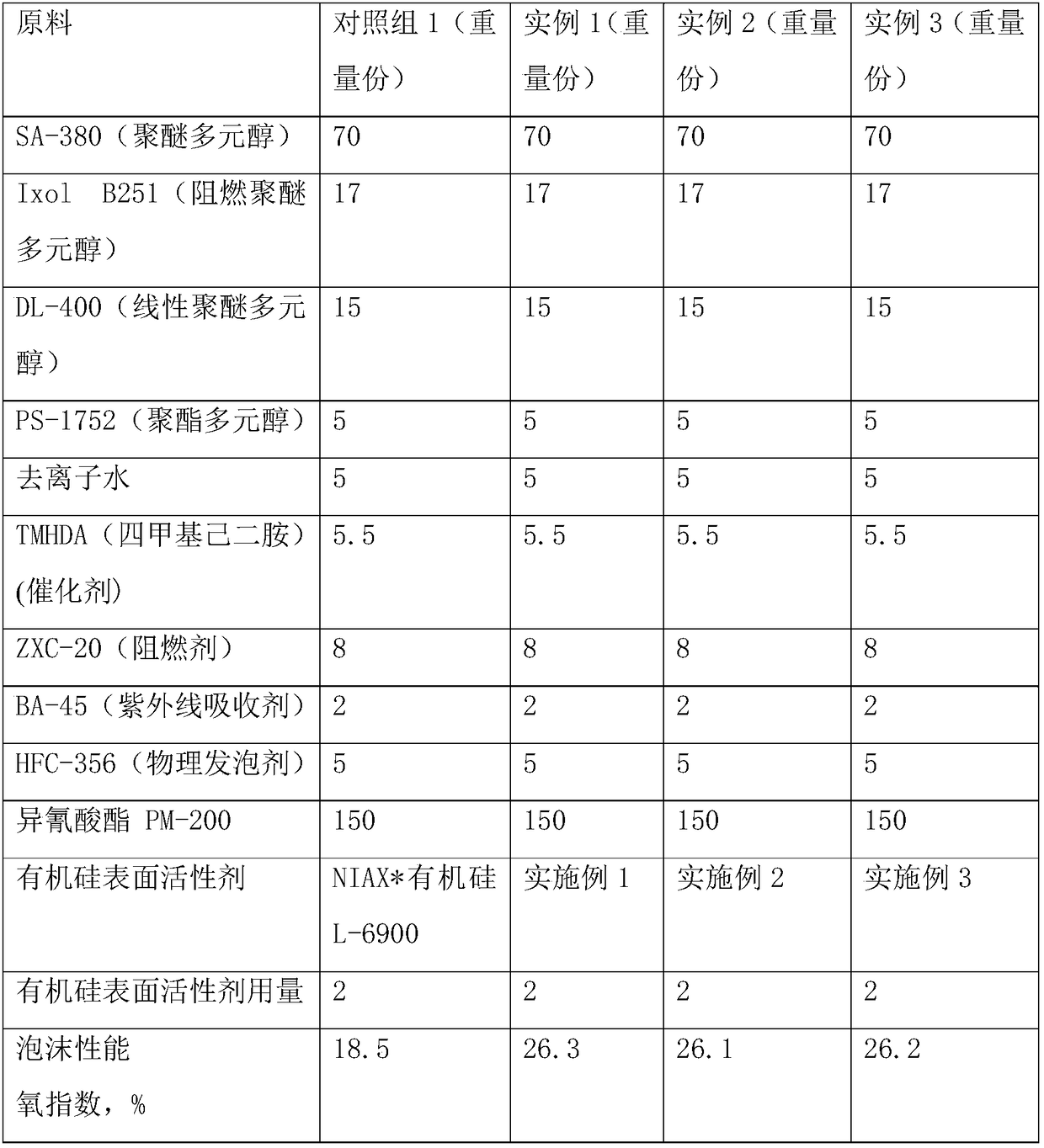Flame-retardant organic silicon surfactant and application thereof
A surfactant and silicone technology, used in the field of surfactants and flame retardant silicone surfactants, can solve problems such as large safety hazards and ozone layer depletion, and achieve improved flame retardancy, fine cells, and storage stability. high sex effect
- Summary
- Abstract
- Description
- Claims
- Application Information
AI Technical Summary
Problems solved by technology
Method used
Image
Examples
Embodiment 1
[0013] The preparation of embodiment 1 silicone surfactant
[0014] In a 500ml four-neck flask with a fixed device, a constant temperature function, mechanical stirring, a thermocouple and nitrogen gas, add 250g of polyoxyethylene ether (called polyoxyethylene ether) with an average molecular weight of 750 methyl-terminated starting from allyl alcohol. Polyether A), this polyether A contains the oxirane group that mol percentage is 75% and the propylene oxide group that mol percentage is 25%; Add 50g allylbenzene, mix and stir 5 minutes at normal temperature, then 150g Low hydrogen polysiloxane (referred to as MD 40 D' 12 M) Add it into a four-necked flask, start stirring, heat to 75°C with a heating mantle, stir for 5 minutes, add 20ppm of Pt chloroplatinic acid ethanol solution, and react for 4 hours to obtain a clear and transparent light yellow liquid, which is organic Silicone copolymer surfactant.
Embodiment 2
[0015] The preparation of embodiment 2 silicone surfactants
[0016] In a 500ml four-neck flask with a fixed device, constant temperature function, mechanical stirring, thermocouple and nitrogen gas, add 240g of polyoxyethylene ether (called polyoxyethylene ether) with an average molecular weight of 500 methyl-terminated starting from allyl alcohol (called Polyether B), this polyether B contains the oxirane group that the molar percentage is 60% and the propylene oxide group that the molar percentage is 40%; Add 60g2,4-diphenyl-4-methyl-1- Amylene, mixed and stirred at room temperature for 5 minutes, and then 140g of low-hydrogen polysiloxane (abbreviated as MD 40 D' 12 M) Add it into a four-necked flask, start stirring, heat to 75°C with a heating mantle, stir for 5 minutes, add 20ppm of Pt chloroplatinic acid ethanol solution, and react for 4 hours to obtain a clear and transparent light yellow liquid, which is organic Silicone copolymer surfactant.
Embodiment 3
[0017] The preparation of embodiment 3 silicone surfactants
[0018] In a 500ml four-neck flask with a fixed device, constant temperature function, mechanical stirring, thermocouple and nitrogen gas, add 300g of polyoxyethylene ether (called polyoxyethylene ether with an average molecular weight of 1250) of methyl-terminated starting from allyl alcohol. Polyether C), this polyether C contains the oxirane group that is 60% by mole percent and the propylene oxide group that is 40% by mole percent; Add 100g allyltriphenylphosphine bromide, mix and stir at room temperature for 5 Minutes, then 100g of low hydrogen-containing polysiloxane (referred to as MD 40 D' 12 M) Add it into a four-necked flask, start stirring, heat to 75°C with a heating mantle, stir for 5 minutes, add 20ppm of Pt chloroplatinic acid ethanol solution, and react for 4 hours to obtain a clear and transparent light yellow liquid, which is organic Silicone copolymer surfactant.
PUM
 Login to View More
Login to View More Abstract
Description
Claims
Application Information
 Login to View More
Login to View More - R&D
- Intellectual Property
- Life Sciences
- Materials
- Tech Scout
- Unparalleled Data Quality
- Higher Quality Content
- 60% Fewer Hallucinations
Browse by: Latest US Patents, China's latest patents, Technical Efficacy Thesaurus, Application Domain, Technology Topic, Popular Technical Reports.
© 2025 PatSnap. All rights reserved.Legal|Privacy policy|Modern Slavery Act Transparency Statement|Sitemap|About US| Contact US: help@patsnap.com


